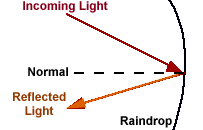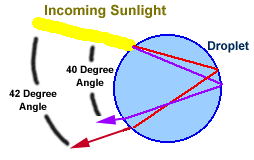|
|
. |
Rainbows
an arc of concentric colored bands
[Image: a rainbow (53K)]
Photograph by:
Holle |
A rainbow is an arc of concentric colored bands that develops when sunlight
interacts with rain drops. |
A rainbow occurs when rain is falling in one portion of the sky
and the sun is shining in another. For a rainbow to be seen, the
sun must be behind an observer who is facing falling rain.
[Image: animation of how rainbows form (40K)]
Animation by:
Hall |
Sunlight is
refracted
as it enters a raindrop, which causes the different wavelengths (colors) of
visible light to separate.
Longer wavelengths of light (red) are bent the least
while shorter wavelengths (violet) are bent the most.
|
If the angle between the refracted
light and the normal to the drop
surface is greater than a critical angle,
the light reflects off the back of the
drop.
 |
The critical angle for water (which would apply to raindrops) is
48 degrees (relative to the normal).
Therefore, if light strikes the back of a raindrop at an
angle greater than 48 degrees,
it will be reflected back. If the angle
is smaller than 48 degrees, the light will simply pass on through. |
The reflected light is
refracted as it exits the
drop. Violet light (bending the most) emerges
at an angle of 40 degrees relative to the incoming
sunlight
while red light
(bending the least) exits the drop
at an angle of 42 degrees. Other
colors of the rainbow leave a raindrop at
angles somewhere in between.
According to Descartes' calculations using
laws of optics, the three stage refraction-reflection-refraction pattern that
light undergoes when passing through a raindrop
produces a concentration of outgoing
rays along a line that is 42 degrees above the head of an observer's shadow.
This concentration of light rays is the rainbow that we see.
 |
Since only one color of light is observed from each
raindrop,
an incredible
number of raindrops is required to produce the magnificent
spectrum of colors
that are characteristic of a rainbow. |

water droplets
|
|

primary rainbow
|
|



